#Baltic mythology
Text
NAKSHATRAS AS GODDESSES
1/27
🐎ASHWINI🐎
DISCLAIMER: This is based solely on my research and the patterns that I saw. I can't promise that I'm gonna be sure in all the coorelations, but I'm going to attribute each nakshatra a goddess that I think fits it the closest. If you're dissapointed, to make up for it, I'm going to list some other deities in the end that I think also fit the nakshatra. Don't come for me if you think I'm wrong, be respectful in the comments if you think so and have fun 🤍
While researching, at first it was obvious that no deity was as perfect for Ashwini as Ashwini Kumaras themselves. I still tried to search for a Goddess that would be most similar to this nakshatra's energies and I kid you not, I've found the exact goddess I was looking for. Definitely was not expecting this.
Saule
Pronounced "sow-lay"

Pantheon: Lithuanian
Name meaning: The sun
Main associations: The Sun, fertility, healing, helping women and children, red apple, gold.
Symbols: The Sun, apples, colors gold and red.
The Baltic people believed the Sun to be a disc, dancing and rolling around. Saule is the literal representation of the sun, who, not unlike the Greek god Helios, rides a chariot pulled by two horses. The horses are mostly described as white and sometimes golden, and they're called, believe it or not, the Asviniai. It seems that the word has an Indo-European root.
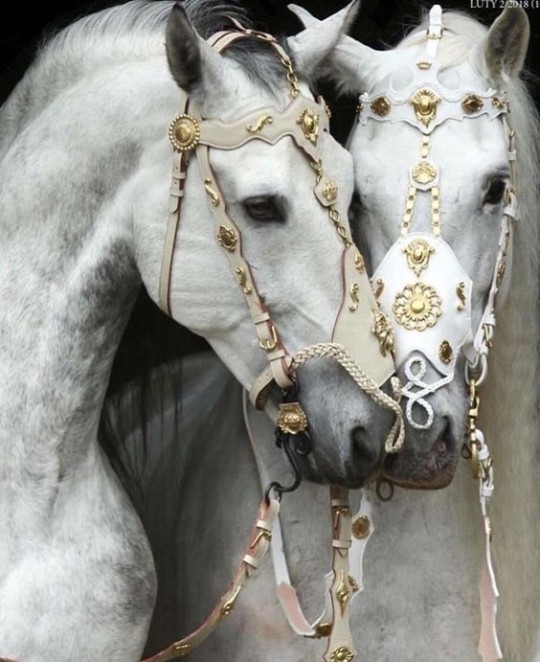
The deities assigned to Ashwini are Ashwini Kumaras_twin horsemen, depicted as young, healthy and handsome men who can heal people.

Like their power, Saule is associated with healing, regeneration and also fertility. She rides in her copper-wheeled carriage with her trusted horses, flying through the sky every day, bringing light and warmth to Earth. In regards to her appearance, she's frequently depicted with long golden hair, as well as being associated with gold and amber in general. She's described as being dressed in golden silk. Being the goddess of health and vitality, she had horses that would never tire nor sweat.
At night Saule would bathe her horses and go to the underworld. She was married to the moon god Menesis. Their first child was Earth, then followed other children: the Stars. It's said that her husband was very carefree, sometimes sneaking out of their castle in his moon carriage, thus leaving the world to darkness. Despite having a husband, ultimately, Saule is a sovereign and independent goddess.
As the setting sun, Saule is known as the falling red apple, a ring or a crown. She's strongly associated with the color red, and also apples and apple trees. Other plants associated with her are daisies, sunflowers, roses and linden.
Saule is honored every year at summer solstice.

I want to talk a little about why I coorelated her to Ashwini but first, I'll talk about the goddess extremely similar to her- Norse goddess Sol/ Sunna. She's also associated with the sun, healing, regeneration and has a chariot pulled by two horses, one of which is called Allsvinn (very fast), the other is called Arvak (early rising). Also, one of her many names literally means "Gold".
I think the association of these goddesses with Ashwini kumaras is clear, but I chose the Baltic goddess saule as to me the Baltic culture is more similar to Ashwini's energies than the Norse (You'll definitely see Norse goddesses in this series tho). Baltic people also have gods which are basically their equivalent of Ashwini Kumaras, twin horsemen gods called Ašvieniai. It's crazy to me that two cultures that you wouldn't think have anything in common basically share a deity.
Other deities that can be associated with Ashwini other than Saule:
Sunna- Norse goddess of the Sun, healing and fertility.
Ašvieniai- Baltic twin horsemen gods who have a gift of healing
Rhiannon- Celtic goddess known as "The Horse Queen", goddess of movement, leadership, the night, the moon and death.
Epona- Celtic goddess most strongly linked to horses (and you can tell by her name)
That's it for Ashwini🤍❤ I love my horse- people😅🤍 I genuinely do, there's no one like you guys, you are very healing and refreshing to be around. Keep going 🐎🐎
Don't forget to comment if u liked this or you can interact in any way .
#ashwini#ashwini nakshatra#baltic mythology#saule#goddess saule#nakshatras#vedic astrology#ashwini kumaras#sun goddess#sun in ashwini#moon in ashwini#ascendant in ashwini#moon in ashwini nakshatra#sun in ashwini nakshatra#ascendant in ashwini nakshatra#ketu in ashwini#ketu in ashwini nakshatra
94 notes
·
View notes
Text

L take imo anyways meet Saulė and Mėnulis, the sun goddess and moon god respectively of baltic (specifically lithuanian) mythology
#chaotic but like not on topic#lithuania#lietuva#baltic mythology#mythology#preparing a speech abt mythology is SO stressful i wouldnt wish that on a single person. the only saving grace is that i LOVE to talk#well that and bc i need to write my own myths for lore stuff so good references etc etc
49 notes
·
View notes
Text
Here's my another art work from my art school 🏫 💖 ✨️ 💓 💛 💕
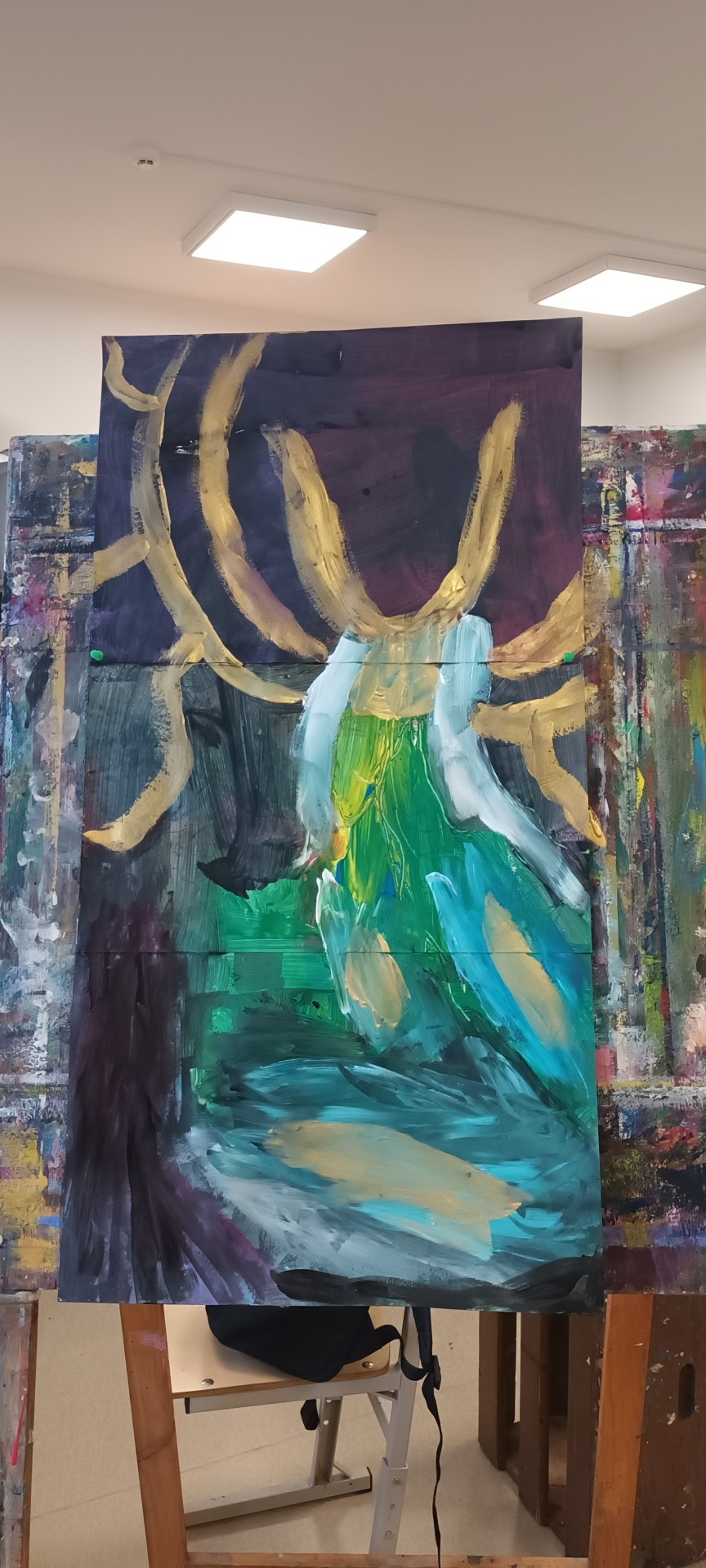
I gonna call this painting Saulė The Goddess of the Sun
Saulė is The Goddess of the sun from my Baltic Lithuanian culture mythology and also Latvian mythology too
#lithuanian artist#baltic artist#european artist#beginner artist#wannabe artist#small artist#small art account#my artwork#my art#traditional art#acrylic art#my culture#baltic mythology#lithuanian mythology#latvian mythology#lithuanian hetalian#hetalian
38 notes
·
View notes
Text
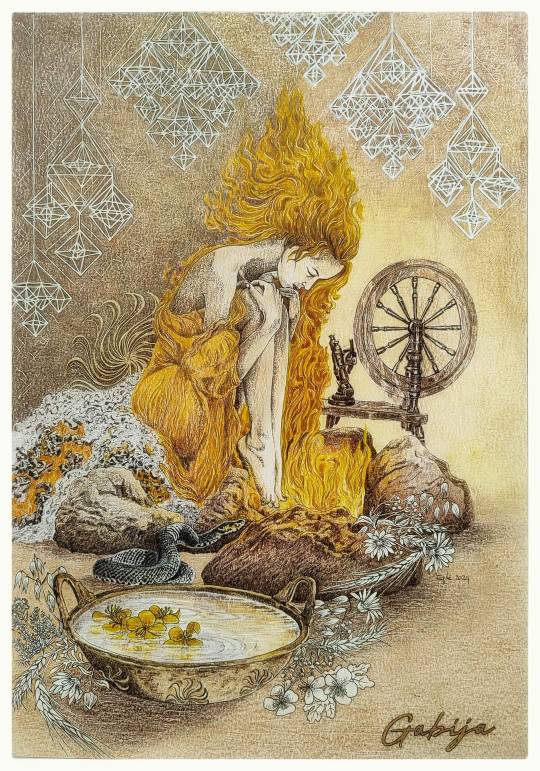
Gabija, the guardian of the home hearth:
She is also Ugnija, and Ugninė (Fire, Fiery), and Peleno deivė (Ash goddess), and Pelengabija.
Illustration by Eglė Abariūnienė.
8 notes
·
View notes
Text
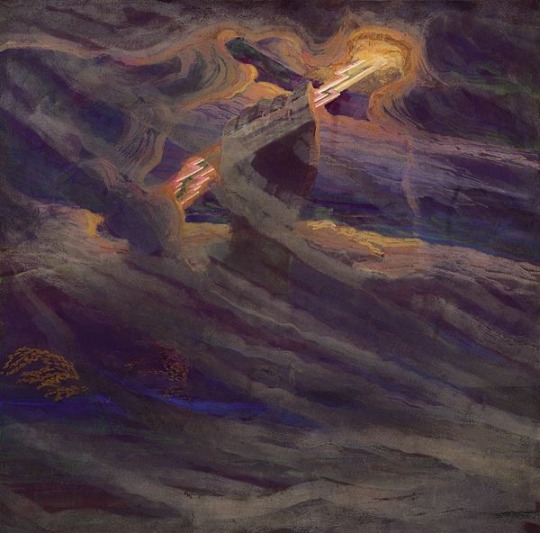
Perkūnas
The Lithuanian god of Thunder
Attributes: lighting, storms, the sky, an axe or sledgehammer
Animals: goat
Plants: oak
Colours: black, white, grey
The sky deity of the Baltic religion, Perkūnas, is regarded as a fertility god and the guardian of law and order apart from being the god of thunder and lightning. Perkūnas is the most important Lithuanian god, and is the central figure in the Pantheon. The oak, which is the tree most frequently struck by lightning, is regarded as sacred to him.
Perkunas is usually depicted as a middle-aged man riding a two-wheeled cart with goats. In some accounts, the thunder god is seen driving a flaming horse or a cart of white and red horses through the skies. He would be identified by the constellation of Ursa Major.
On his heavenly chariot, Perkunas is holding a goat with one hand while he uses an axe or horn on the other.

Mythology
Folklore usually emphasises that Perkūnas is a patron of weather, he lives between the heaven and the earth in the clouds, he commands the thunder and lightning. Thus Perkūnas occupies the centre of the structure of the universe, becomes the master of the atmosphere (Perkūnas is correspondingly associated with the heaven and the devil - Velnias with the earth, underground, water). Perkūnas possesses a two-wheeled cart harnessed by two goats or horses , and rides through the sky , the sound of the wheels often causes thunder. Perkūnas strikes and chases the devil or devils, though often it is said that this animosity is based on personal grounds because of a certain act the devil committed (theft, insult, abduction of Vaiva, as mentioned below).
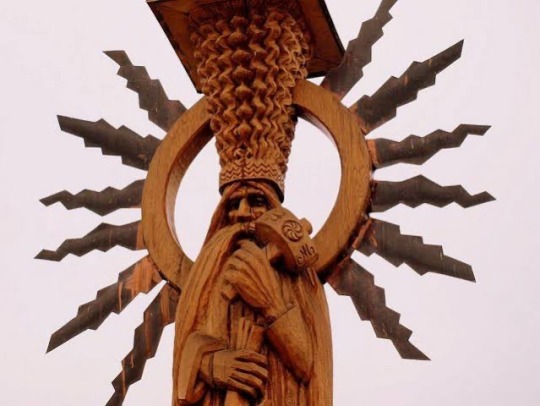
An important function of Perkūnas is to fight Velnias. He is sometimes considered the antithesis of Perkūnas and is the god of the underworld and death. Christianity considers "Velnias" akin to their "devil", though this is not in line with ancient beliefs.
Perkūnas pursues his opponent, Velnias, for picaroon or theft of fertility and cattle. Velnias hides in trees, under stones, or turns into various animals: a black cat, dog, pig, goat, lamb, pike, cow or a person to avoid Perkūnas.
Perkūnas pursues an opponent in the sky on a chariot, made from stone and fire (Lithuanian ugnies ratai). Sometimes the chariot is made from red iron.
Perkūnas possesses many weapons. They include an axe or sledgehammer, stones, a sword, lightning bolts, a bow and arrows, a club, and an iron or fiery knife. Perkūnas is the creator of the weapons (Akmeninis kalvis, "the stone smith") or he is helped by the heavenly smith Televelis (Kalvelis).
Perkūnas simultaneously is given the function of the patron of fertility, when he rolls his thunder for the first time in spring the grass starts growing, the processes of vegetation begin, Perkūnas also appears in the wedding symbolism. One other function of Perkūnas is keeping justice. He chases devils but he also punishes bad people, fights evil spirits and keeps the order of the universe.
According to ancient tradition, people who were struck by lightning were protected from devils. The objects that were struck by lightning were also used to cure various ailments, such as fever, toothache, and anxiety. Perkūnas is thus seen as a god of healing as well as destruction.
In some songs Perkūnas, on the way to the wedding of Aušrinė (dawn; the daughter of the Sun), strikes a golden oak. The oak is a tree of the thunder god in the Baltic mythology. Lithuanian Perkūno ąžuolas or Latvian Pērkona ozols ("oak of Perkūnas") is mentioned in a source dated to the first half of the 19th century.
Perkūnas is also connected to Thursday. Thursday is the day of the Thunderer in many traditions: compare Polabian Peräune-dǻn ("day of Perun"), Lithuanian Perkūno diena. Perkūnas is associated with the Roman god Jupiter in early sources. Thursday is a day of thunder-storms and rains, and also of weddings.
Family
In most myths, Perkūnas’s wife is Žemyna, the goddess of the earth. In some myths, Perkūnas would expel his wife and children and then remain in the sky by himself. The reason for this is that Perkūnas was given the responsibility of the stones in the sky whose rumbling and rubbing against each other tend to generate thunder and lightning during storms.
In songs about a "heavenly wedding" Saulė is married to Perkūnas amd cheats on Perkūnas with Mėnulis (the Moon); Perkūnas splits Mėnulis in half with a sword, which accounts for the moon phases we see today.
According to another, more popular version, Mėnulis cheats on the Sun with Aušrinė (the morning star) just after the wedding, and Perkūnas punishes him. However, he does not learn and repeats the adultery and is punished again every month. Other explanations say it is why the Sun shines during the day and the Moon at night. Though divorced, both want to see their daughter Žemyna (the Earth).
Some stories claim that Perkūnas and a woman known as Vaiva or the rainbow were supposed to get married but the bride was kidnapped by Velnias, the god of the underworld. Since then, Perkūnas has been hunting Velnias. Some stories also claim that there are four sons of Perkunas who are representative of the four seasons or the four cardinal directions. Sometimes there are seven or nine Perkūnai referred to as brothers. It is said in Lithuanian "Perkūnų yra daug" ("there are many thunders").
#Lithuanian mythology#baltic mythology#baltic paganism#perkūnas#Perkunas#thunder god#Lithuanian deities#thunder#lightning#paganism#witchblr#paganblr#mythology and folklore#mythology
29 notes
·
View notes
Text

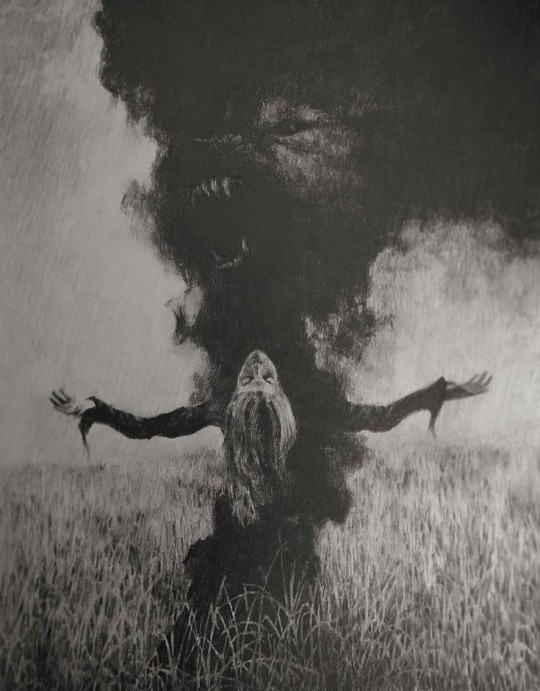
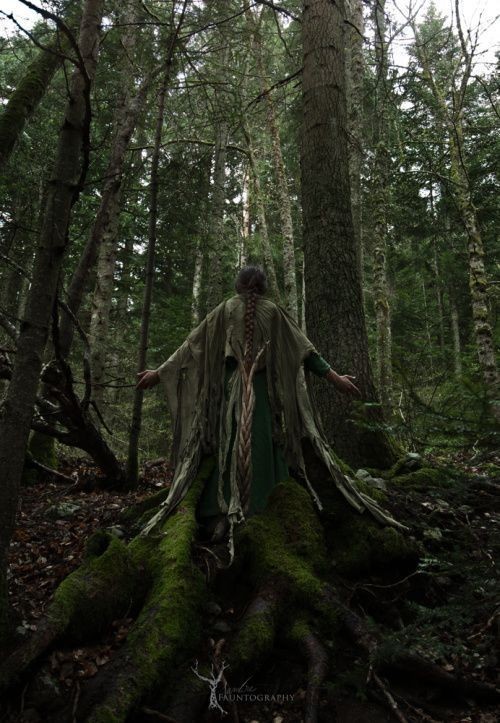



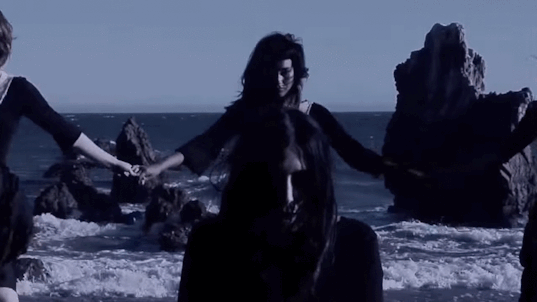


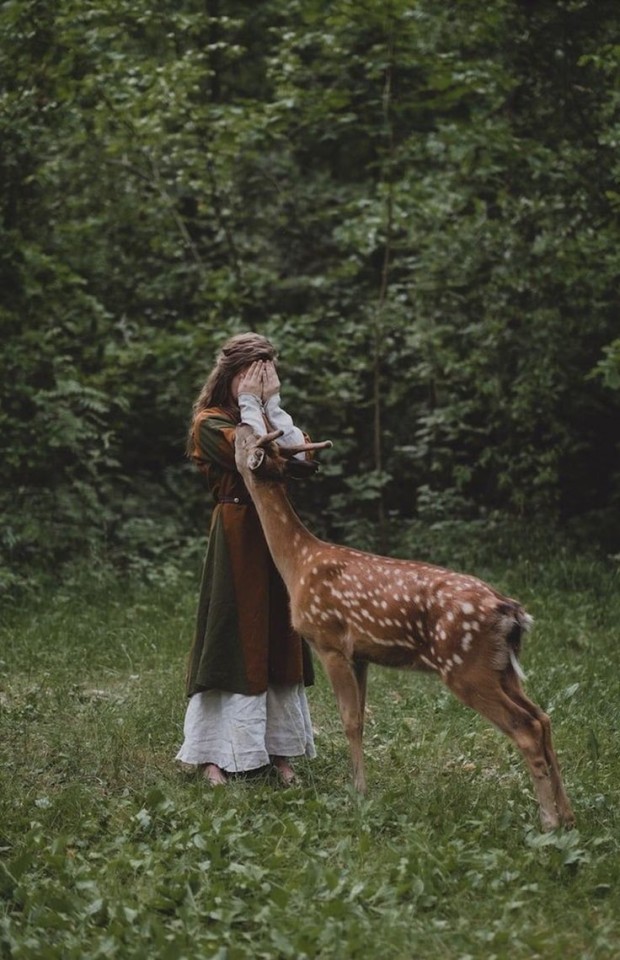
"Ragana's name derives from a root word meaning "horn" or "crescent". Alternatively, her name derives from a root verb meaning "to see". Ragana is an ancient pre-Indo-European spirit, a powerful prophetess who reveals the future. She also knows the past: devotion to Ragana dates back to the Neolithic era, the New Stone Age.
Ragana rules over night, winter, birth, death, destruction, rebirth and regeneration. She is a goddess of fertility, abundance and menopause, which begins with the touch of her red wand. Ragana, the prophetess, sees all, knows all and is all-powerful. She is a goddess of death and a master healer who can supposedly cure any illness or disease.
Ragana can bless or curse. She controls the fertility and milk supply of women and animals. It causes and cures infertility and impotence. Ragana controls the weather, raising and calming storms and winds. She is the guardian of the cycles of nature: creation, growth, decline and destruction. Ragana can be understood as a spirit of balance. Even her negative powers can be understood as a blessing. Ragana stops the rise of the sun after the summer solstice. What would happen if the power of the sun was not controlled? If after the Summer Solstice, the power of the sun only increased?
"Ragana was demonized long before Christianity arrived in the region. Worshiped before the arrival of the Indo-Europeans, she was never assimilated or incorporated into their pantheon, in which male deities like Perkunas play dominant roles. Pre-Indo-European goddesses were assimilated by marriage to these deities. Ragana, apparently not ideal wife material, was not married to any of them. Author Vilija Vyté in the book Of Gods and Holidays: The Baltic Heritage describes Ragana as the "nightmare of patriarchy".
After the arrival of Christianity, her image only worsened: Ragana was demoted to a witch who supposedly brings misfortune to humans and animals, a warning perhaps intended to make devotees stop worshiping her. Fairy tales often portray Ragana as grotesque. The stories simultaneously celebrate and warn against it. Like her Russian soul mate, Baba Yaga, Ragana may be portrayed as a cannibal, but her spiritual appeal and mastery remain powerful. Ragana is invoked in positive and malevolent magic. Spells and enchantments attempt to focus (or redirect!) her legendary destructive powers against the spellcaster's enemies. She is an increasingly popular neo-pagan goddess."
#history#Ragana#ragana#goddess of witches#witch#baltic mythology#Goddess#Baltic goddess#goddess of witchcraft#Goddess ragana#Lithuanian mythology#history of women
22 notes
·
View notes
Text
Lithuanian and broadly Baltic symbols for the sacred žaltys snake, compared to the "cool S" or "stussy" that was somehow ubiquitously drawn by bored middle schoolers. We are just drawn to honor the snake :3~



#judgment snake#snake cult#Zinnia's snake cult#cool S#stussy#Lithuania#Lithuanian mythology#Baltic mythology#Lithuanian folk religion#žaltys#snakes#tw snakes#grass snake#Natrix natrix
37 notes
·
View notes
Text

...
To be honest, I'm surprised they aren't married in mythological canon, knowing the Olympian family tree.
Or, maybe, my thinking is just affected by Baltic mythology. The Sun and the Moon are often portrayed as married in my culture (the genders are the opposite, by the way - the Sun is female, the Moon is male). Or divorced. In that one song, the Moon does cheat on the Sun with the Evening Star, and gets hacked in half with a sword during the divorce.
#greek mythology#apollo#artemis#apollo x artemis#like greek gods do inc*st and see no problem with it#i guess apollo's nine (9) girlfriends would get mad if he married his sister#baltic mythology#fr for me the sun is a lady the moon is a bloke#and they're married... divorced?... Involved#we have a good outlook on cheating tho don't we#greek mythology fandom#i was looking up apollo and cassandra... don't ask you can find the explanation somewhere in my hoard of ramblings#diary pages
3 notes
·
View notes
Text
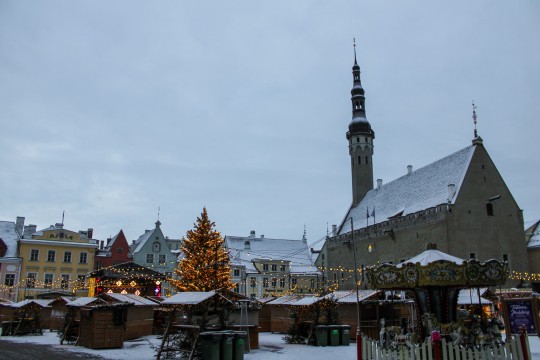

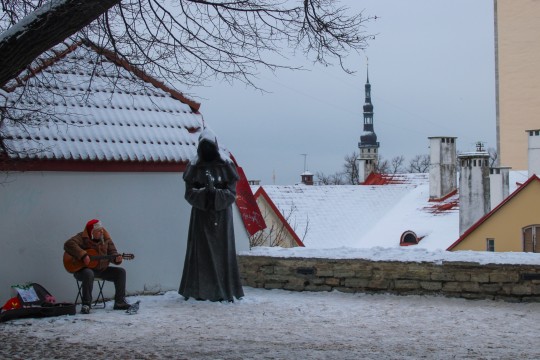


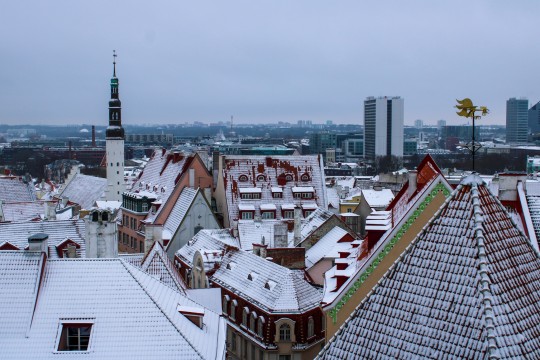


Tallinn, Estonia. 11/2022
#tallinn#estonia#estonian#baltic sea#baltic mythology#baltics#baltic countries#latvia#lituania#eesti#kerli#snow#snowy day#snowy forest#nature#travel#old town#europe#european#northen europe#niguliste#park#memories#the times we had#tartu#parnu#kerli kõiv#ice rink#ice skating
14 notes
·
View notes
Text
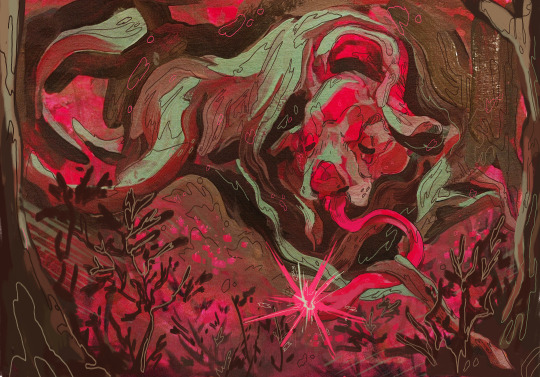
Bloom '23 - robiccup
10 notes
·
View notes
Text
Laima
Laima is a goddess of Baltic, Latvian and Lithuanian mythology. She is the creator of human beings, the personification of destiny and determines happiness and misfortune.
As Laima mate ("lucky mother"), she intervenes in all fateful events such as birth, marriage, ||death,|| fertility one.
She is the patron goddess of pregnant women and women who have recently given birth, as well as of domestic life in general. As long as she stays in the house, everything is for the best.
In particular, she is the tutelary goddess of orphans, for whom she takes on a kind of mother role and guides them into adult life.
Laima is also the goddess of light and darkness.
She also often appears in the form of a cuckoo. Laima's sacred tree is the lime tree. These linden trees have 3, 5, 6, 7 or 9 branches - these are also the sacred numbers of the goddess Laima.
Laima often appears in Latvia together with her sisters Kārta and Dēkla as the trinity of goddesses of fate. In Europe and the Aegean there is a widespread belief that fate lies in the hands of three ageless women, as in those of the Greek Moirs, the Roman Fates, the Eastern European Sudice or the Germanic Norns.
This also applies to the "Tris Laimas", of which Laima is by far the best known. Laima determines the birth of a human and determines the fate of the newborn. Later she appears as Dēkla or Kārta.
Depictions of Dēkla often show her as a nurturing goddess with children at her breast. Kārta probably stands for the death aspect the Great Goddess.
In Lithuania the goddess Giltine is considered to be the Sister of Laima that brings death.
Laima or her sisters are often depicted seated at the spinning wheel or loom, spinning and weaving the threads of destiny.
Laima, as the goddess of fortune and misfortune, is also able to help desperate people. Many folk songs mention that Laima weeps when she sees the effects of an unfortunate fate.
However, people should not remain in their misfortune and wait for the help of Laima, but at least take one step - namely to approach the divine and thus steer their gaze, their thoughts and their orientation in a different direction.

13 notes
·
View notes
Note
Hello! I came across your blog and saw that you had listen Baltic/Slavic practices as a semi closed / open by blood/lineage. Recently I have been looking into my ancestry and by asking my family, looking at family trees, etc, and I have found that I have some latvian ancestry (one of my great grandparents immigrated) Along with German and some other things (Im very white lmao). I was wondering if that would make it okay for me to practice some aspects from it? I grew up disconnected from the culture and I don't want to "reclaim" something that isn't mine to reclaim. Also if you have any resources about the culture, why its semi-closed, etc. It would be greatly appreciated!! Sorry if this is kind of long, I don't really like bothering people with asks but I swear it's so difficult to find information on this kind of stuff!!
Hello there!
A great grandparent is a good chunk of blood lol More if you add the German part.
I (personally) think you are fine, you are very close to these roots to be able to reconect with them withou feel like a colonizer.
Usually the cultures closed(or semi) by blood is mostly based to the idea than many of these cultures have been historically hunted by other biggers cultures/religions, to the point that their practices were tagged as witchcraft/heresy. By blood usually means "You need to belong to us, you need to have our culture and histories in your blood".
The culture of the baltic states has been destroyed over and over generation after generation because they keep getting eaten by bigger and bigger fish (Persia, the Ottomans, the Nazis, the Soviets) so what we can get now from internet have nothing to do with their roots. Wiki says "The Balts originally practiced Baltic religion. They were gradually Christianized as a result of the Northern Crusades of the Middle Ages. Baltic peoples such as the Latvians, Lithuanians and Old Prussians had their distinct mythologies. The Lithuanians have close historic ties to Poland, and many of them are Roman Catholic. The Latvians have close historic ties to Northern Germany and Scandinavia, and many of them are irreligious."
Also sadly (or not), this closed cultures tend to keep their practices in secret to be teached between members of their communities (the mouth to mouh), so there will be a huge amount of info that you will not be able to get unless a Baltic member tell you.
For example, oomancy (egg reading) tend to be open and closed at the same time because is a practice that evolve globally, but also have their particularities between the different cultures (including the Baltic oomancy).
I have a not a lot of info sadly, sorry, but I guess, as everything, the best is start easy and general, like wikipedia, and keep searching more in depth. For what I know, neopagans in the Baltics developed the Romuva (derived from the traditional mythology of the Lithuanians, attempting to reconstruct the religious rituals of the Lithuanians before their Christianization in 1387), maybe you can check that?
I welcome anyone else if they can bring more info!
I hope I was somehow helpful, sorry for my english, I'm awake since 6am and is currently midnight hahaha * cry tears of blood *
8 notes
·
View notes
Text
Baltic Pantheon: Dievas
So firstly, this is just my own modern take on the Baltic mythological God, I have way more sketches made. But I introduce you to - Dievas, the highest God in the Baltic pantheon. When speaking about this God, he/she/they (plural and singular) all work, as Dievas has no single form.


Now onto the story I made around Dievas.
“The Story of Creation”
In the vast empty void, Dievas floated in it. In a sudden crack of anger and paranoia, they created the universe with a massive explosion. In a day, that by human standards, lasted billions of years the planetary systems and life was created.
Dievas once again saw that their destructive tendency crated perfection. And that’s when they noticed the Earth, populated by a variety of animals. This is where she felt sad, as no creation was evident on this planet. Thus, from the soil he formed man and woman.
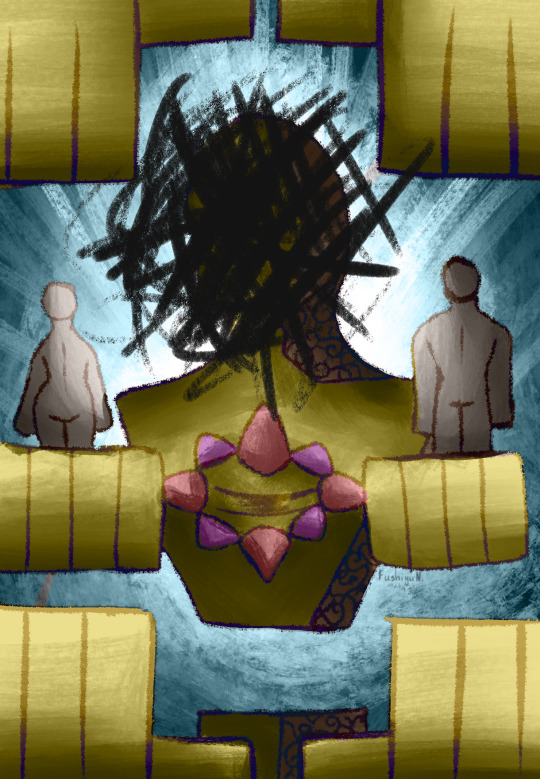
The perfect dichotomy, perfect balance. The two first humans were hailed as the highest magnum opus Dievas had created. The purest form of their being condensed in flesh. Lovingly, Dievas let the humans roam the Earth, being overjoyed at seeing them create art, buildings and other materia.
There was only one request: “You have been given eternal life, plentiful fruit, but you must not touch the eternal fire”.

The eternal fire was a gift to every single planet - the partial remains of Dievas. It is the ethereal materia that fed from the misery and pain from the world, cleansing it from such experiences.
The man and woman knew nothing of this. For hundreds of years they lived on the planet until their curiosity got the better of them.
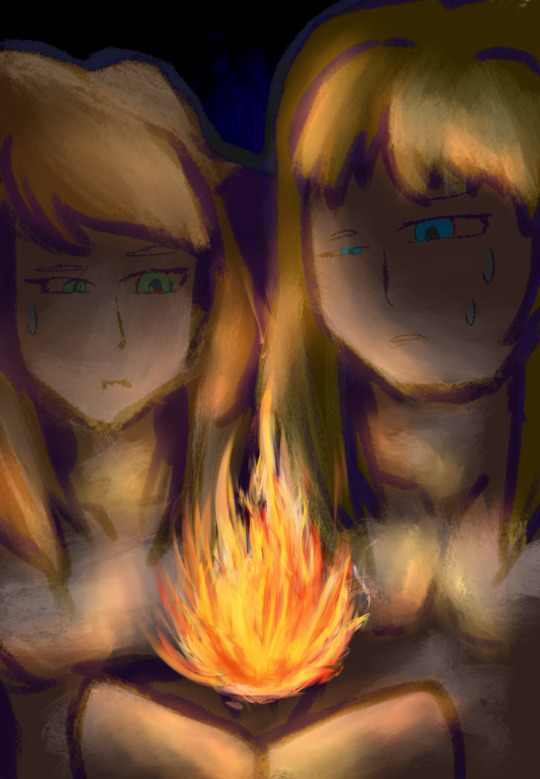
Humanity finally held the sacred fire. But that was a grave mistake.
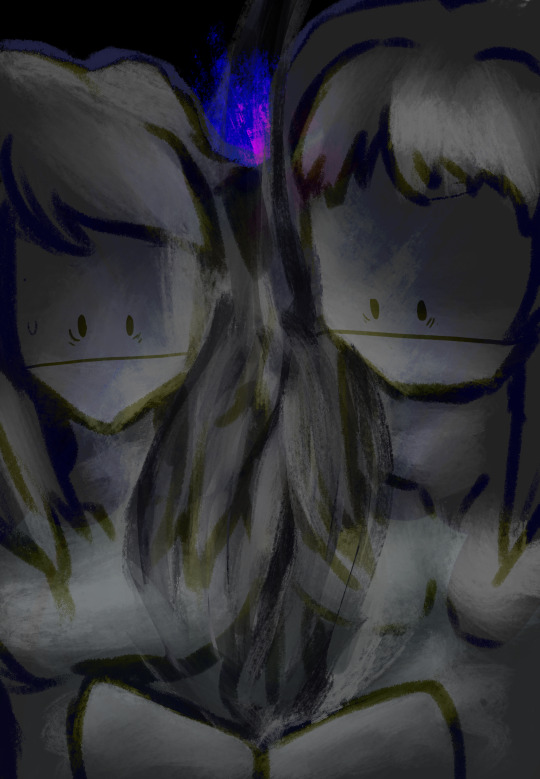
With their touch, the eternal fire fizzled out and died. The wisdom and pain of the fire was absorbed by humanity, the link with Dievas was broken.
With that single action, the sky turned crimson as whails of despair shook from the planet, death and suffering flooded the Earth.
This didn’t go unnoticed by Dievas as their screeching from the skies pierced the ears of the living.
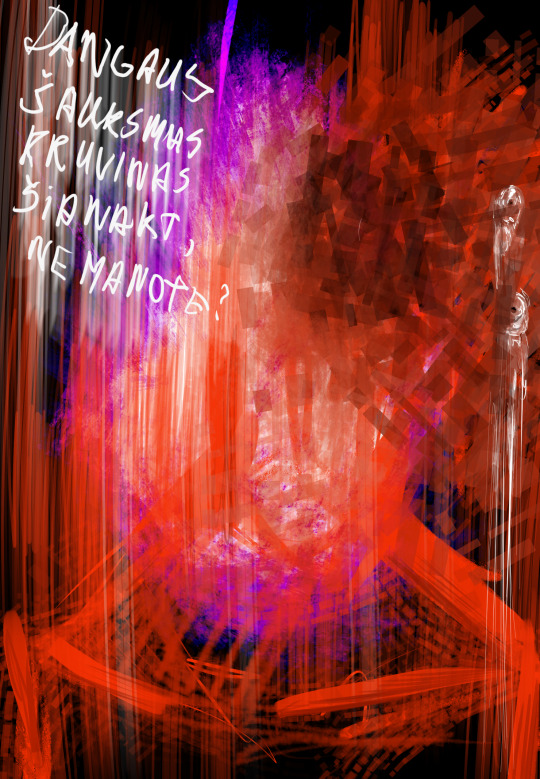
Devine anger struck from the skies. The black squiggly mist began to disappear from the Dievas face, every step taken on the mortal realm left dead land behind them.
At the peak of their anger, the mist dissipated …

“The Devine light has been severed from these lands!”
The very essence of life was sucked away beneath their being. Any bits of soil turning to sand as revenge.
But Dievas was beyond angry. His light was absorbed by humanity. Her connection severed from her joy. Their being killed by their own creation.
As retaliation, they took the woman and man…
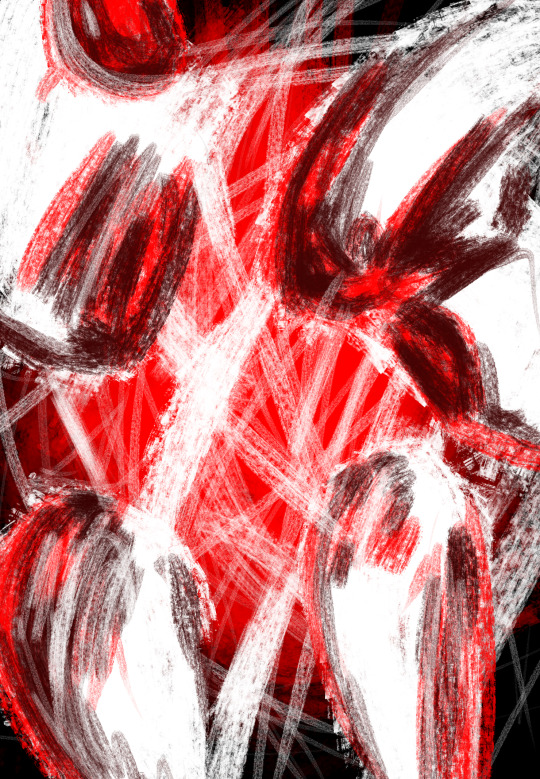
Dievas ripped their bodies apart. From their tendons they weaved new humans. In pain, her hands sewn the parts of woman to man. In revenge, he reassembled parts of man to woman. The perfect balanced was severed. New humanity was a chaotic mesh of their former creation.
But after Dievas calmed down, they looked at what they had done in a fit of rage, feeling shame and regret they fled off to not set foot on Earth again. That is when the other Gods were created - to manage Earth for them.
Dievas feared that their restructuring of humanity meant that their creation was doomed to die off in misery…
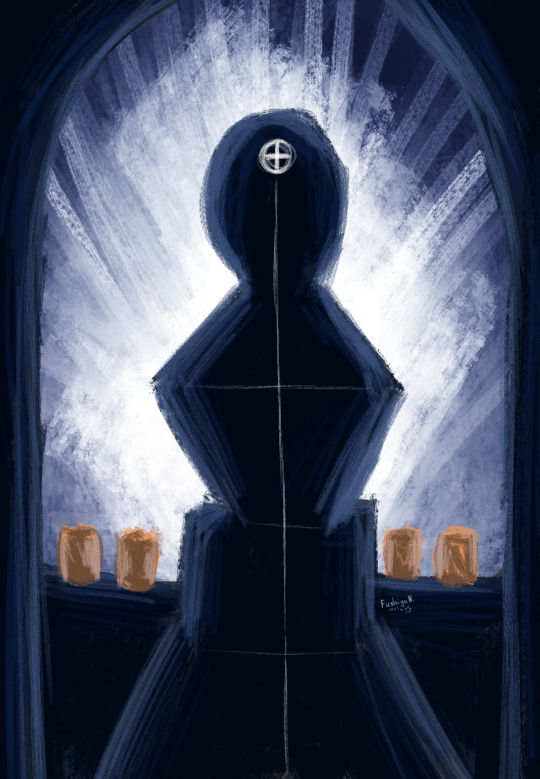
But Dievas forgot that their hands were created to keep balance. Everything done always leads to perfection.
The new humanity, even though restructured, was just as perfect. Man fell in love with woman, man with man, woman with woman. But even more so - humanity broke the very essence of the dichotomy introduced by Dievas. Humans were not tangled by the idea of man and woman, humanity broadened what it means to be human and what that experience would entail.
Dievas could only look with curiosity as their destruction of the binary balance created a spectrum of experience that created equilibrium in itself.
Once again the God could be proud of their creation, having created something more complex, something more… perfect.
2 notes
·
View notes
Text
Sun Goddess in Baltic Mythology
Sun Goddess in Baltic Mythology
Later, this period of anticipation for Saule’s return came to be known as the Christian advent. Saule was depicted as having golden hair. golden silk clothing, a golden scarf, and a golden crown. Two white horses called Asviniai dragged her chariot as it was raised to the heavens. Saulé has a strong connection to the sea, where it is thought that she rode at the conclusion of her daily voyage and…

View On WordPress
9 notes
·
View notes
Text
BRO WHATTTT
"The Slavs took over the worship of Perkūnas from the Lithuanians. The Slavic Jupiter was Jessė, and after taking over the rite from the Lithuanians, they began to call it Perun. Already in 980, Vladimir The Great introduced his worship to Kyiv, placing his idol on the mountain, which he had seen in Lithuania when he was staying there, having fled from Novgorod, fearing his brother Yaropolk. And his representative Svinield at the same time introduced the rite of Perun in Great Nogard. In Kyiv, the idol was wooden, the head was silver, the mustache was golden (Slavs then shaved their beards, only wore mustaches) and held a flint in his hand. Oak wood was constantly burning near the idol. After being baptized, Vladimir worshiped that idol in 988, dragged him down the Dnieper and let him swim down. The russians did not worship Perkūnas and the very name was foreign to them (Prof. A. Brückner)."
"Parjanya (Devanagari पर्जान्य, - literally "rain cloud") is the god of the thunder cloud and rain in Vedic mythology."
"Згідно з першою, особове ім'я *Perunъ утворено від дієслова *pьrati («бити, ударяти», пор. укр. прати) і суфікса діяча -unъ (пор. «бігун», «стрибун» тощо). Таким чином, враховуючи, що Перун вважався покровителем війська, а отже і битв (пор. укр. заст. пря «бій», «боротьба», «борня»), ім'я Перун має значення «Той, що пере, б'є, ударяє (громом і блискавкою), заохочує на прю». Подальше перенесення: «бог грому» → «грім, блискавка» закріпилось в слов'янських мовах ідентичними словами, що позначають грім і блискавку — заст. укр. перун («грім»), заст. біл. пярун, заст. рос. перун («блискавка»), пол. piorun («грім»). У сілезькому діалекті польської використовується вигук «Jerunie!"
Funny enough because Baltic Prussians (I guess) call a general "Jenerolė". (In the song "Neišeik, Saulala"). I need to study Silesian language asap.
#okay i can agree with the part where russians didn't worship perun#but who the hell is Jessė???#Lithuania#Lithuanian mythology#paganism#baltic mythology#slavic mythology#Ukraine#Belarus#linguistics
7 notes
·
View notes
Text

if it looks weird, its a dragon
#medieval inspired#dragon art#dragon oc#original creature#original species#mythologyart#baltic mythology#sorta kinda based on latvian mythology
3 notes
·
View notes